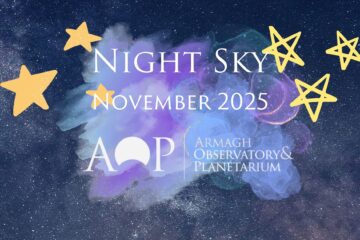Article written by: Ria Mee, Education Officer
Finally, we have left the January blues behind us, the month that never seems to end. Now it is time for February fun! The chill in the air has well and truly settled in and it looks like it will be staying with us for a while yet. Let’s just hope there’s no snow, although beautiful it’s not very practical, we’re not very well equipped for dealing with the snow! However, there is a silver lining as the February night sky has some of the most well-known constellations visible.
At the beginning of this month there will be a New Moon, 4th February, so this is the perfect time to go stargazing as the Moon will be located on the same side of the Earth as the Sun and so not visible in the night sky. This means that the sky is much darker making it much easier to see fainter objects. This makes it the perfect time to go planet spotting. For those early risers both Venus and Jupiter are visible from a South Easterly direction around 5.15am. While Mars is still visible from approximately 5.30pm facing in a Westerly direction although quite low on the horizon. Let’s just hope that there isn’t too much cloud cover.
During this dark month, on 19th February we are treated to a Supermoon, in fact the brightest this year. A Supermoon is a Full Moon, at its very closest approach to Earth in the Moon’s elliptical orbit around us. This will be the second of the three Supermoons this year, but this Supermoon will be the closest to Earth at a mere 356,846 km away. So make sure you take this opportunity to witness it, as you will have to wait another eight years to see a Supermoon as good as this one!

This February we can see one of the most popular constellations in the night sky, in fact it is one of the signs of the Zodiac and this creature has two very pointed horns. This spectacular constellation is Taurus the Bull and in Greek mythology Taurus was the God Zeus who had disguised himself as a magnificent white bull so that he could abduct the beautiful princess Europa. The star marking the red eye of the bull is a bright star called Aldebaran. Aldebaran is roughly 150 times bigger than our Sun and is approximately 65 light years away from Earth. This red giant star is nearing the end of its life, as it has depleted all of its hydrogen supply and is currently expanding in size. Aldebaran means the ‘follower’ as it appears to follow a nearby star cluster across the sky. This star cluster is called the Pleiades or more commonly know as the Seven Sisters.

The Pleiades is a relatively young cluster of stars. As these age they will spread out into the surrounding Galactic region. We can use the Pleiades to test how clear our night sky is. You are lucky to see six stars in the cluster, as not even the keenest sighted person can make out its seven brightest stars. However, through a telescope you can see hundreds of stars in this cluster, but in fact long exposure photographs taken by the Hubble Space telescope have revealed over 1,000 stars. The mythology behind the seven sister is somewhat cruel. The story goes that the parents of the seven sisters asked Zeus to place the sisters in the heavens so that they could escape Orion the Hunter who was desperately trying to purse them. (We have previously mentioned Orion in our December’s night sky and even then, he was up to no good!). Unfortunately, little did the parents know that Orion would be placed so close to the sisters in the night sky!

Looking South we can see another zodiacal constellation, Gemini, which means twins in Latin, the two bright stars mark the heads of the twin boys, called Castor and Pollux. Pollux is the brighter of the two and located 34 light years away however Castor is more interesting because through a powerful telescope it reveals a multiple star system of six stars. In Greek mythology the twin boys had two different fathers. Pollux was the son of Zeus and therefore was immortal whereas Castor’s father was a human being, the king of Sparta called Tyndareus. During battle Castor was killed and Pollux was so devastated by his brother’s death that he asked his father to be with his brother always. So, there we can see the twin brothers hand-in-hand, forever in the heavens.
To finish off there is a very interesting object located inside Gemini constellation the called the Eskimo Nebula discovered by in 1787 by astronomer William Hershel and it is approximately 2,870 light years away from Earth. Unfortunately, you will need a telescope to see it as it is invisible to the naked eye. The origins of its name come from its resemblance to a face peering out of a coat with a furry hood, a little bit like an Eskimo. However, it sometimes gets called the Clown Face Nebula, but you can decide which name suits best.
There we have it, another Night Sky Blog. I would encourage you all to look up at the wonders of the night sky, weather dependent of course. Happy star gazing folks!!


1 Comment
The February Night Sky – 2019 – Dinezh.com · February 4, 2019 at 01:29
[…] Source link […]